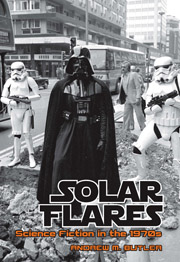Book contents
- Frontmatter
- Contents
- Acknowledgements
- Prologue
- 1 The Ends of First Sf: Pioneers as Veterans
- 2 After the New Wave: After Science Fiction?
- 3 Beyond Apollo: Space Fictions after the Moon Landing
- 4 Big Dumb Objects: Science Fiction as Self-Parody
- 5 The Rise of Fantasy: Swords and Planets
- 6 Home of the Extraterrestrial Brothers: Race and African American Science Fiction
- 7 Alien Invaders: Vietnam and the Counterculture
- 8 This Septic Isle: Post-Imperial Melancholy
- 9 Foul Contagion Spread: Ecology and Environmentalism
- 10 Female Counter-Literature: Feminism
- 11 Strange Bedfellows: Gay Liberation
- 12 Saving the Family? Children's Fiction
- 13 Eating the Audience: Blockbusters
- 14 Chariots of the Gods: Pseudoscience and Parental Fears
- 15 Towers of Babel: The Architecture of Sf
- 16 Ruptures: Metafiction and Postmodernism
- Epilogue
- Bibliography
- Index
9 - Foul Contagion Spread: Ecology and Environmentalism
- Frontmatter
- Contents
- Acknowledgements
- Prologue
- 1 The Ends of First Sf: Pioneers as Veterans
- 2 After the New Wave: After Science Fiction?
- 3 Beyond Apollo: Space Fictions after the Moon Landing
- 4 Big Dumb Objects: Science Fiction as Self-Parody
- 5 The Rise of Fantasy: Swords and Planets
- 6 Home of the Extraterrestrial Brothers: Race and African American Science Fiction
- 7 Alien Invaders: Vietnam and the Counterculture
- 8 This Septic Isle: Post-Imperial Melancholy
- 9 Foul Contagion Spread: Ecology and Environmentalism
- 10 Female Counter-Literature: Feminism
- 11 Strange Bedfellows: Gay Liberation
- 12 Saving the Family? Children's Fiction
- 13 Eating the Audience: Blockbusters
- 14 Chariots of the Gods: Pseudoscience and Parental Fears
- 15 Towers of Babel: The Architecture of Sf
- 16 Ruptures: Metafiction and Postmodernism
- Epilogue
- Bibliography
- Index
Summary
Science fiction often depicts the interaction between the environment and its inhabitants. There are correlations between individuals, their physical setting and the surrounding flora and fauna; an ecosystem of greater or lesser consistency is depicted. The environment itself may become a character in the narrative, especially as an antagonist to the hero, an often unstoppable and sometimes invisible set of forces. The continued rise of consumerism and the post-industrialised West in the 1970s, as represented in an increasingly global and globalised media, put a growing strain on raw materials, fuel and labour. Earth was imagined as a single unit, for example as the Spaceship Earth of a speech by Adlai Stevenson in 1965, in Kenneth E. Boulding's ‘The Economics of the Coming Spaceship Earth’ (1966), which contrasted open and closed systems, and in Buckminster Fuller's Operating Manual for Spaceship Earth (1968). Harry Harrison adopted the phrase to refer to the moral he perceived behind Soylent Green (Richard Fleischer, 1973), a loose adaptation of his Make Room! Make Room! (SF Impulse August–October 1966; 1966): it ‘shows what the world will be like if we continue in our insane manner to pollute and overpopulate Spaceship Earth’ (1984: 146), an idea he had already advanced in his short story ‘Commando Raid’ (1970): ‘The richest countries better help the poorest ones, because it's all the same spaceship’ (1977: 122). Barry Commoner argued that there was only one ecosystem, and that everything came from somewhere and went somewhere, with resources likely to be turned from useful to useless. Natural systems kept resources generally renewable.
- Type
- Chapter
- Information
- Solar FlaresScience Fiction in the 1970s, pp. 120 - 135Publisher: Liverpool University PressPrint publication year: 2012



